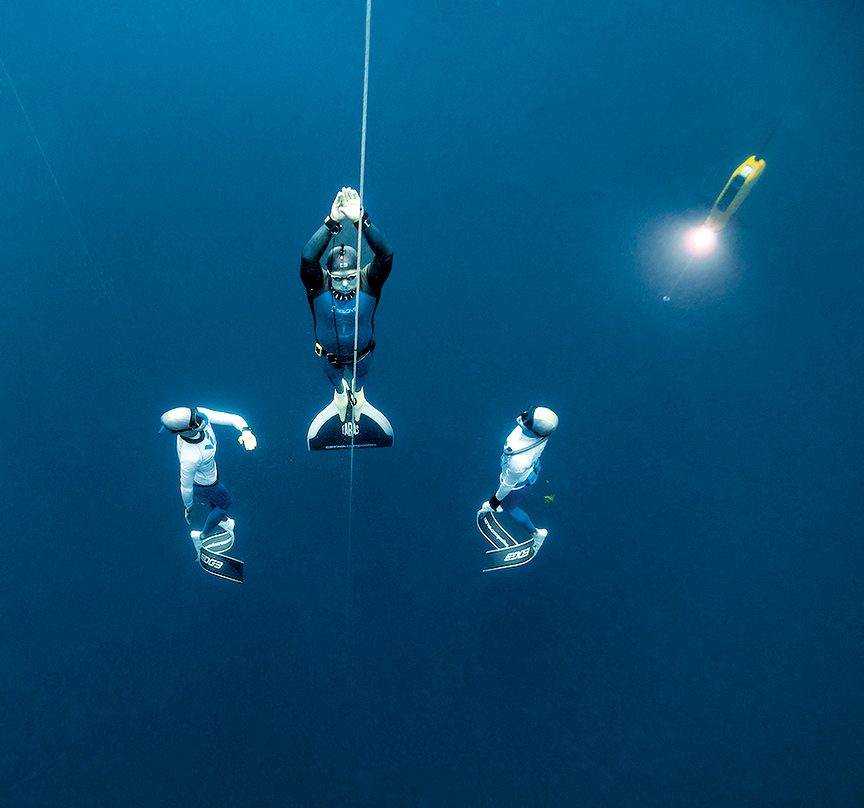Safety 101
THE RAPID GROWTH OF FREEDIVING in the U.S. brings a positive light to a sport that is mentally healthy and physically inspiring but has little tolerance for error. Shallow-water blackout and respiratory barotrauma are the most feared consequences of freediving, but they can be minimized with training and good safety practices.
Serious consequences have been linked to freedives that lacked the basic one-up-one-down rule, bypassed the buddy system, and pushed limits without proper safety measures. But not knowing your blind spots is perhaps as dangerous as not knowing how to freedive. Risk assessment implies assessing the scene and anticipating problems before starting the freediving session. It involves ensuring that we have safety measures in place in case of an unexpected event.
That assessment includes having a written emergency action plan (EAP) for any freediving event, whether it’s a competitive or a complex recreational one. An EAP specific for your dive site and scenario is crucial and clearly delineates what to do in an emergency. The following are basic items to consider when doing a thorough mental risk assessment and building an EAP for freediving.
Certification
Make sure all participants are certified freedivers. A freediving certification teaches the basic safety standards to follow and provides prevention tips. No checklist replaces successfully completing a certification course with a qualified instructor in person.
Dive Site Inspection
A thorough inspection of a freediving site considers potential marine life hazards, water current, sea state, and water visibility. It is a safe practice for all participants to use a lanyard attached to the vertical line when visibility is poor. Remember to also inspect the access to water (e.g., rocks, boat, walkway, etc.) to prevent out-of-water trauma or falls.
Identify Closest Medical Facilities
Smartphones have made it much easier to map the fastest route to the closest medical facility, but don’t skip identifying the nearest appropriate location to treat freediving emergencies before you dive. This precaution can save a life. Do this each time you plan a freediving session, whether the dive site is new or well known.

Juan Valdivia performs a constant-weight monofin ascent from 60 meters, flanked by two safety divers, using proper underwater safety technique. Photo courtesy Juan Valdivia
Evacuation Methods
Have a designated person who’s responsible for being the evacuation driver of your preplanned method of transportation in case of an emergency. Predetermine a safe evacuation route to take to the nearest medical facility.
Communication
Make sure you have an adequate cellular signal for your phone at a dive site, which can be an issue in remote areas. Plan to have alternative communication methods available to contact emergency services by using a marine radio, satellite phone, or personal locator beacon.
Emergency Oxygen and First Aid Skills
While it is not mandatory for new freedivers to have first aid certification, we highly recommend taking a basic life support certification course before taking your first freediving course. Better yet, take a freediving-specific first aid course, if available. Having a DAN oxygen unit with you and available for every freediving session can save a life.
Briefings
Before every session, take at least five minutes for a dry briefing to discuss with your freediving buddies what you all are about to do. Establish basic life support roles, identify safety teams, and assign buddy pairs. Make sure all freedivers present understand the underwater safety framework of how the buoy and line are set up, how lanyards are attached and disconnected, and the presence of any underwater lights.
An in-water briefing is mandatory to communicate to your safety buddy the planned depth, dive time, and discipline you are about to perform. Also make clear the depth at which you want to be met if you desire a depth safety. Conduct this briefing for each dive and for every diver.
Know Your Limits
Know your breath-hold limits and those of your buddies. The risk grading of each dive and each dive session depends on who is diving that day.
Debriefing
If an incident occurs, discuss with the team what happened to prevent future mistakes and to learn specific risks from a dive site, underwater maneuver, or specific diver.
Other Considerations
Rehearse underwater and surface rescue techniques when possible. The “time of immersion” is perhaps the most important factor influencing the outcome of a near-drowning victim. Thus, the rescue phase with rapid in-water action is critical for the victim’s survival and outcome.
Sometimes the wisest decision is to reassess your heath and decide not to dive until you’re well and fully prepared. Never dive alone, and never hyperventilate prior to your dive.
While freediving is growing exponentially in the U.S., it is still a small community. It is our duty to raise awareness about trends over time. This means asking not only if a freediver has had incidents in the recent past but also how severe. Being open about any recent history of freediving incidents, such as blackout or barotrauma, can mean the difference between doing a safe dive or perpetuating a repetitive bodily injury.
The current collective knowledge of freediving safety comes from scientists and medical experts involved in freediving research as well as the elite athletes who participate in the sport and understand the intricate journey a human goes through to safely gain deeper depths on breath-hold. We know some but not all of the risk factors for freediving incidents.
There is much we seek to understand, such as if there are any accumulative negative effects of chronic breath-holding on the human body or whether shallow recreational freediving is safer or more risky than deep competitive freediving, which features safety lanyard connections and dedicated safety divers ready to rescue a participant. AD
© Alert Diver — Q4 2023